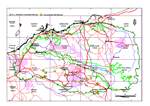Click on images
to enlarge


, BRM 4610, ORIGINAL SCAN, ADJUSTED_sml.jpg)
Photographer: B.R. Maslin
, BRM 4610, ORIGINAL SCAN, ADJUSTED RICHARD WOODMAN_sml.jpg)
Photographer: B.R. Maslin

Photographer: B.R. Maslin
, Rhodes Ridge, BRM 23 May 1982, ORIGINAL SCAN, ADJUSTED RICHARD WOODMAN_sml.jpg)
Photographer: B.R. Maslin

Photographer: J. Maslin

Photographer: B.R. Maslin

Photographer: B.R. Maslin
, BRM 8703, lab photo by Fiona McCallum ADJUSTED_sml.jpg)
Seed from one herbarium voucher. Scale in mm. Photographer: F. McCallum.
Botanical name
Acacia marramamba Maslin, Nuytsia 4: 94, figs 9 & 11 (1982)
Common name
Marramamba
Description
Bushy or openly branched, glabrous shrubs 1-3 m tall, maturing to ±gnarled and straggly small trees to 5 m tall, sparingly branched at ground level. Bark grey, slightly fissured and fibrous towards base of trunks otherwise smooth. Branchlets red-brown, light brown or orange, not pruinose. New shoots vivid light green. Stipules spiny, commonly absent from older branches, mostly 2-4 mm long. Phyllodes asymmetric with the upper margin prominently rounded and the lower margin almost straight, 2-5 cm long, 9-23 mm wide, leathery, scarcely undulate, not shiny, pale milky green to bluish green, not obviously pruinose; main longitudinal nerve situated near lower margin; lateral nerves obscure and sparingly and openly anastomosing; somewhat abruptly or gradually narrowed at apex into a straight, needle-sharp point 1-3 mm long. Inflorescences elongated racemes 6-15 cm long (exceeding the phyllodes); flower buds, raceme axes and peduncles brownish red; peduncles 10-20 mm long; flower heads globular, bright light golden, the red-brown petals often visible through the expanded stamens, 25-35-flowered. Flowers 5-merous; sepals ±free; petals red to red-brown at apex. Pods quite prolific, pendulous, narrowly oblong, rounded over seeds but scarcely constricted between them, 2.5-7.5 cm long, 7-9 mm wide, firmly chartaceous to thinly coriaceous, straight to shallowly curved, light brown (yellow-brown just prior to maturity). Seeds mostly obliquely placed in the pods, widely ellipsoid to almost orbicular, 4.5-5 mm long, about 4 mm wide, dark brown to blackish, not shiny; funicle/aril cream, not encircling the seed, the aril small.
Characteristic features
Bark slightly fissured and fibrous towards base of trunks otherwise smooth. Stipules spiny but commonly absent from older branches. Phyllodes asymmetric with a prominently rounded upper margin, 2-5 cm long, 9-23 mm wide, the midrib situated near the almost straight lower margin, pale milky green to bluish green, not obviously pruinose, narrowed at apex into needle-sharp points, minor nerves sparingly anastomosing. Flower heads round and arranged in long racemes (6-15 cm). Flower buds, raceme axes and peduncles brownish red. Pods shallowly curved. Funicle not encircling seeds.
Distribution and ecology
Occurs in northwest Western Australia where it is scattered across the Pilbara (ranging from Duck Creek Station west of Tom Price, to Balfour Downs Station east of Newman); it also occurs in the adjacent Barlee Range and upper catchments of the Ashburton, Gascoyne and Murchison Rivers (as far south as Mount Fraser). Not a particularly common species and although it does not form dense populations it is generally not uncommon in the places where it occurs. Acacia marramamba grows in skeletal ironstone soils on low rocky hills and mountain ridges (in the Pilbara usually belonging to the Marra Mamba Iron Formation) in open woodlands of Snappy Gum (Eucalyptus leucophloia), scrub or tall open shrubland with A. aneura , A. sibirica and A. maitlandii over spinifex ground cover.
Flowering and fruiting period
Flowers from May to July. Pods with mature seeds have been collected in mid-October (more collections needed to determine the fruiting range).
Affinities
Related to A. inaequilatera and A. trudgeniana both of which are readily distinguished by their thick corky bark, their phyllode nerves which form a close, net-like reticulum and purple-red raceme axes, peduncles and flower buds. Additionally, A. inaequilatera has pruinose branchlets and long funicles which ±encircle the seeds.
Notes
Acacia marramamba can resprout from the base following fire.
This species is attractive even prior to anthesis on account of its colourful flower buds, peduncles and raceme axes and as such may have some horticultural potential.
Conservation status
Not considered rare or endangered.
Origin of name
The botanical name is taken from the Marra Mamba Iron Formation on which the species is frequently found, particularly in the Pilbara.
